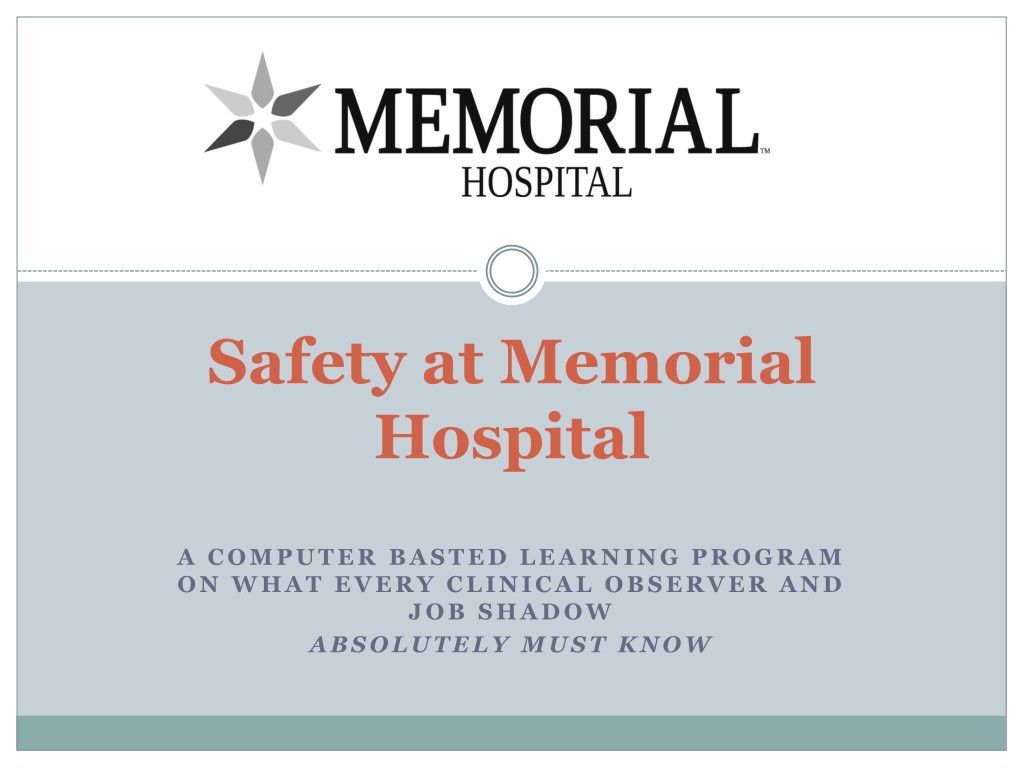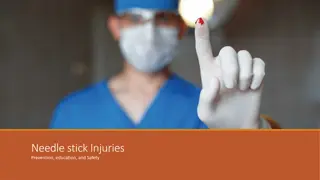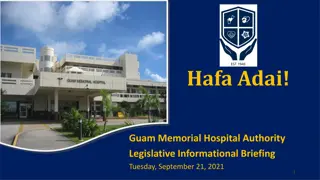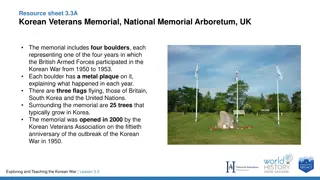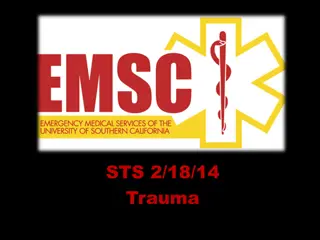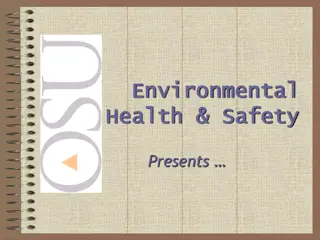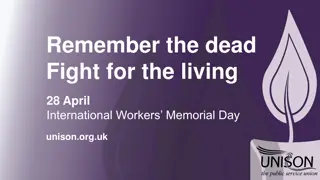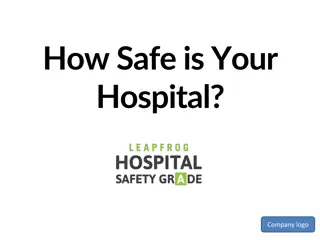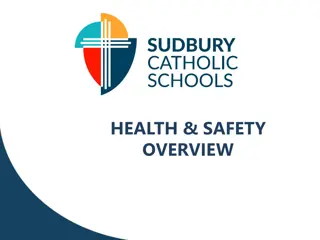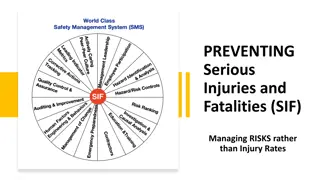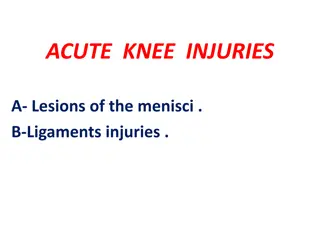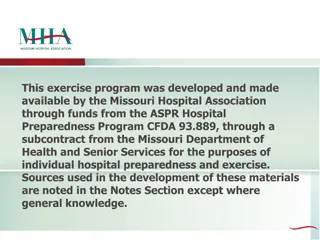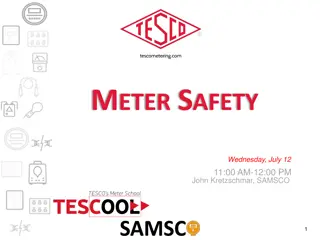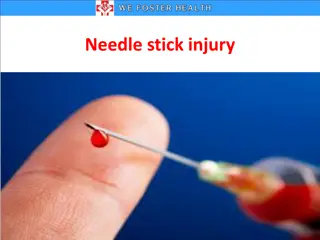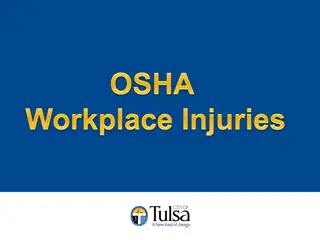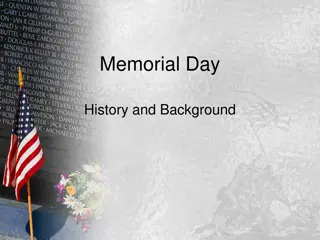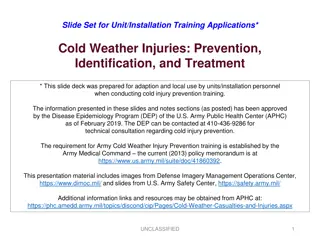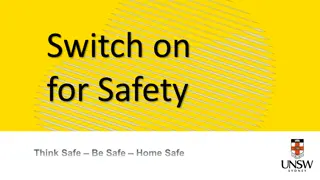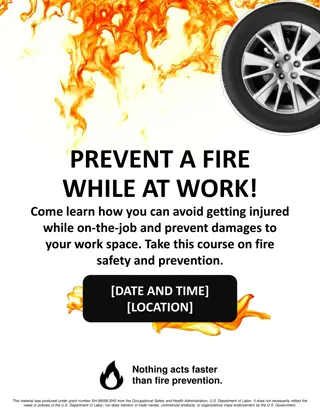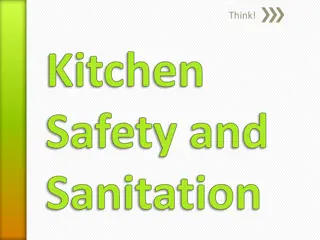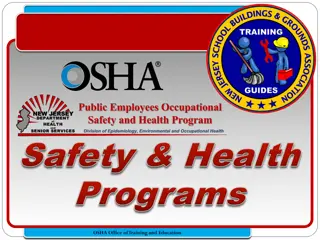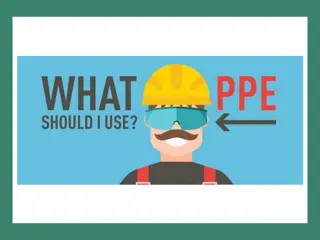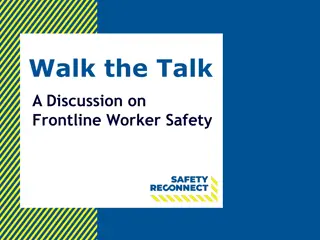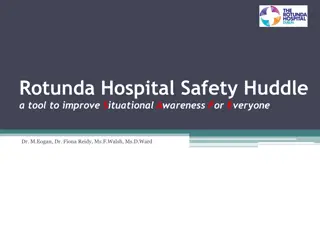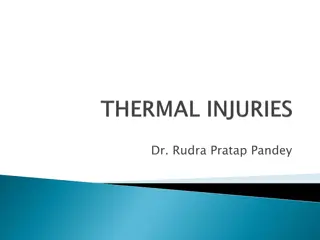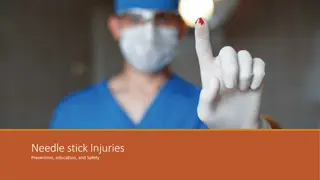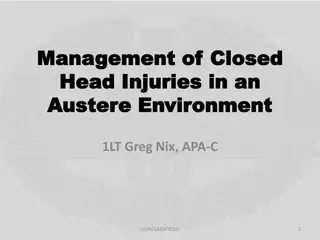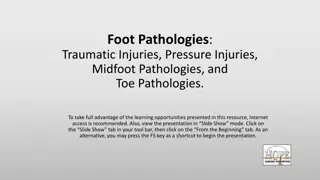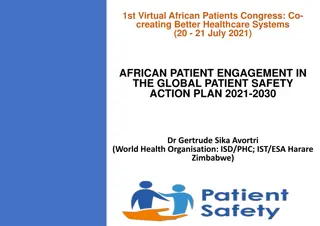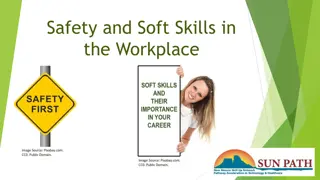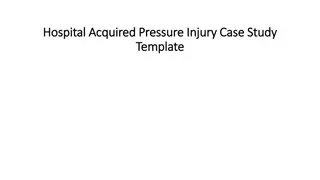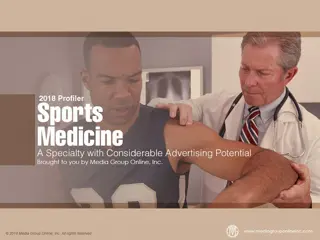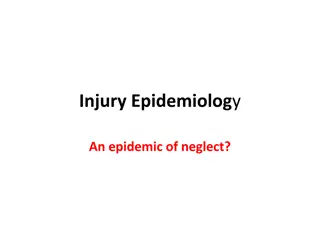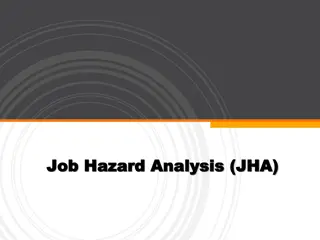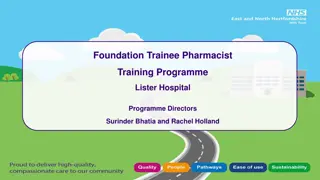Ensuring Patient Safety and Preventing Workplace Injuries at Memorial Hospital
Patient safety is emphasized for all staff at Memorial Hospital, including non-clinical personnel. Everyone plays a role in maintaining a safe environment. The article highlights important practices like reporting hazards, ensuring confidentiality, and improving processes. It also addresses preventing common workplace injuries and those unique to healthcare facilities. By being vigilant and proactive, every individual can contribute to a safer patient care environment.
Download Presentation

Please find below an Image/Link to download the presentation.
The content on the website is provided AS IS for your information and personal use only. It may not be sold, licensed, or shared on other websites without obtaining consent from the author. Download presentation by click this link. If you encounter any issues during the download, it is possible that the publisher has removed the file from their server.
E N D
Presentation Transcript
Safety at Memorial Hospital A COMPUTER BASTED LEARNING PROGRAM ON WHAT EVERY CLINICAL OBSERVER AND JOB SHADOW ABSOLUTELY MUST KNOW
Please take the time to carefully read the following presentation; then complete the provided quiz. If you have any questions about the safety material, please contact Kelly Joliff, Coordinator, Epidemiology & Emergency Preparedness at (574) 647-2238 or Betsy Smith, Safety & The Joint Commission Coordinator at (574) 647-2290. For any safety concern, call the Safety Hotline: (574) 647-7233.
Patient Safety What Does This Mean to Me? Patient Safety is often viewed as an issue that relates only to Memorial s clinical staff, and some people even feel that there is little that non-clinical staff can do to impact the safe delivery of care to our patients. Even if you are not directly involved with clinical care delivery, you remain one of the key Memorial resources that help define the most exceptional care in the world. Here are just a few ways that you can make an impact in your work: Imagine Yourself to Be a Patient. If you see anything hazardous, report it to the information desk. By keeping your eyes open and thinking like a visitor or a patient, you may help our clinical staff recognize ways of improving care delivery. Look Around. Is your work environment safe and does all your equipment work the way that it was intended? Can anyone overhear your comments? All patient information is confidential. Be Accurate. Remember that whenever you work with patients, be accurate. Be Timely. Show up when you promised. Give reasonable time estimates. Improve Your Processes. Keep a good lookout for processes that need to be improved; don t just accept the old adage that it s always been done this way . If you see a work process that is unsafe, then it needs to be fixed! The suggestions above represent only a few of the many ways that a clinical observer (C/O) or job shadower (J/S) can directly influence the surroundings of our patients. Please take a few moments to look around and help Memorial create a safe patient care environment. All of Memorial s patients and visitors will thank you for it!
Maintaining a Safe Environment Preventing Common Workplace Injuries Use proper tools and techniques to prevent personal injuries that can occur among all workers in all industries, especially those injuries that result from: Slips on wet floor surfaces Trips and falls in work areas and walkways Musculoskeletal disorders due to heavy lifting and/or repetitive use of certain joint areas of the body Use of hazardous products Equipment transport Preventing Injuries Unique to Health Care Facilities Use proper tools and techniques to prevent personal injuries and illnesses for which health care workers are uniquely at risk, including those that result from: Needle sticks Exposure to infectious diseases Use of specialized equipment (such as equipment that relies on radioactive or chemical substances) Patient transport
Safety for C/O or J/S What do you do if You are injured while working? Notify your immediate supervisor All accidents need to be reported even if there is no injury. For incidentals, band aids can be found areas you will be completing your clinical observation or job shadow For over-the-counter pain medicines, ambassadors may purchase packages from the Gift Shop or 2nd floor 24hr self-service vending mart located in the Leighton Heart & Vascular waiting area. You are exposed to blood or body fluids? Notify the administrative supervisor immediately. Wash the area of your skin with soap and water. Call Security to make out a security report and if needed you will be seen in the ER. When should you contact security? When you need an escort to your vehicle. When you encounter a potentially violent situation. When you go out to your car and your battery is dead or you have a flat tire. If you are in any of the parking areas and are in need of security either for assistance or to report a problem use the emergency phones located under the blue lights. Call x6920 for non-emergencies.
Emergency Code What it Means What You Should do Follow RACE (Rescue, Alarm, Confine, CODE RED Fire or Smoke HOSPITAL EMERGENCY CODE SYSTEM Extinguish/Evacuate) procedures, clear hallways. Reportby dialing 44 . Call 44 to report, begin CPR and Cardiac or Respiratory Arrest CODE BLUE ACLS procedures. Keep halls clear for code team. Call 44 to report, contain spill if possible, evacuate area and prevent access. Re-direct any contaminated individuals outside to the ECCAmbulance entrance. Call 44 to report. Team will respond to site. Stay back unless specifically trained. Hazardous Material Incident HAZARDOUS MATERIAL Incident Additional events not listed (Information system/network failures - Downtime and weather events (i.e. Tornado)) will be announced in plain language. (Formerly Code Orange) SECURITY ASSISTANCE NEEDED (FormerlyCode Violet) Violent/Combative Patient, Visitor or staff member SECURITY ALERT-ACTIVE Call 44 to report.Shelter in place until all Person with Weapon/Hostage SHOOTER/ARMED INTRUDER clear. Do not go to location of (Formerly Code Silver) danger. Call 44 to report. Provide description of missing person. Search your immediate area for children or items which could contain children, monitor hospital exits, call 44 to report suspicious or uncooperative people Remain calm, get as much info as possible. Call 44 to report. Report any suspicious packages/devices to security. Avoid Cell phone use. Immediately Call 911 to report then Missing infant, child, or adult. MISSING INFANT/CHILD OR ADULT (Formerly Amber Alert) Call 44 for Emergencies from any Memorial Phone or SECURITY ALERT-BOMB THREAT (Formerly Code Black) Bomb Threat WATER RESCUE EMERGENCY (EPWORTH) Person entering the river 647-1000 from any phone call 44 . Obtain Water Safety Equipment and proceed to area where accident (Formerly Code White) occurred. Emergency Incident Report to supervisor, activate any EMERGENCY PLAN ACTIVATION Response program department specific protocols, submit startup. staffing/bed info for level 3 or higher. (Formerly Code Yellow) Levels 1, 2, 3, 4
Code Red Buildings are designed with fire safety in mind. Fire/Smoke walls help contain smoke into compartments. Fire Doors shut automatically when smoke alarms are activated and also help to contain fire. Corridors are designed to give a safe way to exit the building. Fire alarm pull stations near exits and stairwells. When a fire alarm pull station is activated -the fire alarm will sound -Fire doors will close -strobe lights are activated -Elevators move to the ground floor and are disabled. You should be familiar with the location and operation of fire extinguishers!!
Code Red: What to Do in Case of a Fire Remember the acronym RACE Rescue anyone in the immediate area of the fire Activate the alarm by calling the hospital operator and pull the fire alarm pull stations Contain the fire- close doors and windows in the immediate fire area Extinguish the fire with the proper fire extinguisher
Code Red: What to Do in Case of a Fire Remember the acronym PASS Pull the pin out of the handle of the fire extinguisher Aim the nozzle of the extinguisher at the base of the fire Squeeze the handle of the extinguisher to activate the spray Sweep the base of the fire with the spray from the extinguisher
Code Blue Cardiac/Respiratory Arrest As a C/O or J/S, you are not allowed to perform CPR. Call 44 and give the operator as much information as possible. Keep the area clear for the code team.
Hazardous Material Spill Hazardous Chemicals Location - All Material Spill Inform patients, visitors, and non-essential staff to leave the area immediately. Limit traffic through area as safely able. Dial 44 to report Code Orange and provide location. Provide information about product if known (i.e. Sure Flow Drain Opener), any physical characteristics (blue liquid, quantity) and any symptoms (burning eyes, etc). Look up MSDS sheet through Hospital intranet>General Info>Material Safety Data Sheets>type in product name>View/print MSDS. Report to employee health for evaluation. Location-All Training. A staff member or ambassador should NEVER use a chemical for which that person has not been trained. Training includes hazards of the chemical; cautions when using the chemical; safe work procedures; what to do if exposure to skin or inhalation; and MSDS, labels, and other reference material. Report. Report all unsafe conditions and all hazard Chemical incidents to your supervisor. In case of a hazardous materials spill: Call 44 to report Hazardous Material Spill, contain spill if possible, evacuate area and limit traffic through area if safe to do so.
Missing Infant/Child or Adult What you Absolutely MUST know: Amber Alert is the hospital s code which initiates a process to locate a missing/abducted person (infant, child or adult). When there is a report of a missing/abducted person, immediately assess the area to determine if in fact there is a missing person. Call 44 an ask that a Missing Infant Child or Adult be called providing the Operator a description of the missing/abducted person and the location last seen. Family members or witnesses should remain at the scene. Check all areas in your immediate vicinity, adjacent hallways and bathrooms for the person. If an infant or child is missing/abducted, watch for people with a child under the age of twelve (12) or a person with clothing or a container in which a child might be located. People fitting this description should be asked to remain at that point until they are cleared by Security. Call 44 to contact Security. Ambassadors near exit doors should monitor people exiting. If you identify a potential abductor, or people refuse to cooperate, do not attempt to restrain the individual. Call 44 to inform and Security will respond to the scene.
Infant/Child Abduction What you Absolutely MUST know: Infant abductors tend to be unconnected to the child or parents and often dress like a hospital staff member. The Infant is not usually visible, so containers and other ability to hide the infant must be considered. A child abductor is often the non-custodial parent. Hospitals that have been successful in preventing an abduction have had ALL Staff Members acting as the eyes and ears of the organization to protect the infant or child. Ask visitors with children to stop - tell them a child is lost and we need everyone to just stop while we find the child. Parents will usually be cooperative because they understand the fear of losing a child. If you encounter someone who is uncooperative, do not put yourself in harm. Observe the person as long as you can, note their appearance, what they are wearing or carrying, where they go, etc. Call 44 to notify Security immediately. Write your observations down. Anything might help.
Infection Control- Hand Washing Hand washing is the Number One thing you can do to prevent infections Every C/O and J/S is expected to Wash their Hands at these times Beginning and end of each work shift Before eating or handling When obviously contaminated by handling of soiled items After using restroom After Sneezing, Coughing, or Blowing Nose Before and After each Patient Contact How to Wash Your Hands Wet hands in a moderate stream of water Apply soap and lather well Rub well lathered hands together for minimum of 15-20 seconds Rinse hands under running water Hold fingers downward until dried with a paper towel Turn water off with paper towel. Discard paper towel in wastebasket
Infection Control- Hand Sanitizer REMEMBER PUMP IN, PUMP OUT When entering and exiting patient rooms How much hand sanitizer: Apply a dime sized amount of hand sanitizer to the palm of one hand. Rub hands together covering all surfaces of hands and fingers until hand sanitizer is absorbed. Hand sanitizer is just as effective as soap and water and can be used: Before you enter patient room and when you exit After escorting patient in wheelchair Touching door handles and general duties Hand sanitizer should not be used: After restroom use Visibly soiled hands Before/after eating
Maintaining a safe environment is important for the health of patients, employees, and everyone else who enters the facility. Think Safety First!
